The biggest temptation on the London Marathon is to run into a pub along the route.
– Joe Strummer (The Clash), 1983
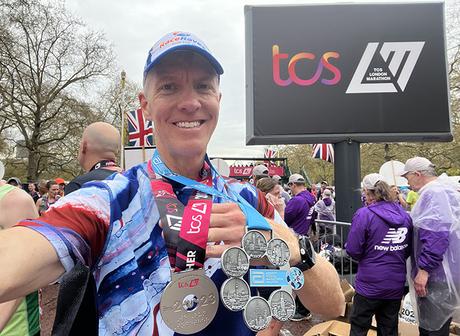
Rarely does a marathon go according to plan. It’s a universal truth I learned—and learned to accept—long ago. For every finish line you cross, there’s always something that could have gone better, whether it’s something you can control like your nutritional intake, or something that’s totally out of your hands like the weather. Some race days, you’ll wake up feeling born to run; other times you’ll realize before you can even break a sweat that it’s not your day.
With 50 marathons under my belt as I write this, I’ve experienced all of the above and more. But I’d never experienced anything like London.
By all accounts, my arrival in London should have been cause for personal celebration. Most importantly, it would be the triumphant finale to my decade-long goal of completing all of the Abbott World Marathon Majors, a wildly popular series comprising six of the world’s largest marathons: Berlin, Boston, Chicago, London, New York City and Tokyo. Runners who complete all six marathons—in no particular timespan or chronology—earn the highly coveted Six Star Medal, which to my mind may be the most beautiful medal in the sport. It’s a magnificent piece of hardware, though whether it’s ultimately worth the time, effort and resources required to earn it is a highly personal question each runner has to answer for themselves. So far, for 12,772 motivated marathoners (including 2,866 U.S. finishers) through 2023, the answer has been an unqualified yes.
Not only would London be my sixth World Marathon Major, it would also be my first marathon in more than 16 months after a ruptured Baker cyst behind my knee, followed in short order by a bone bruise in my lower leg, sidelined me for the entire 2022 racing season. Those 16 months were the longest I’d gone without running a marathon since—well, since I’d first run a marathon in 2010.
If the term “bone bruise” sounds to you—as it did to me when I first heard it—like a “rub some dirt on it” type of injury, trust me it’s not. Case in point, pro basketball player Kendrick Nunn missed the entire 2021–22 NBA season with a bone bruise in his knee. Basically, as I understood it, my bone bruise was a result of edema (swelling) within the bone that would subside gradually on its own over the course of several months. In my case, my orthopedic surgeon’s best guess was that my particular injury had resulted from the repetitive stress/overuse of distance running coupled with very tight hamstrings, which attach to the lower leg more or less at the site of the injury.
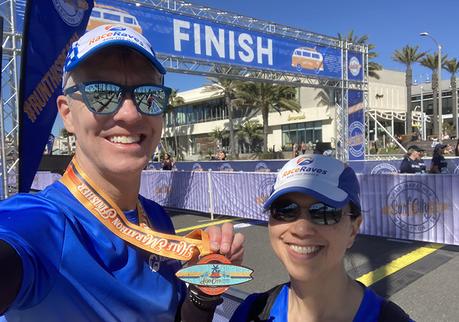
The funny (in the non-amusing sense of the word) thing was, most of the doctors I saw on my road to recovery assumed that, regardless of what they told me, as a crazy runner guy I’d be back out running in no time, injured or not. My physical medicine doctor told me the story of one runner who’d come to him in severe pain after injuring her knee, but rather than play it smart and give her body time to heal, she’d requested the doctor do whatever he could (within ethical limits) to enable her to run the upcoming Boston Marathon. I assured him Boston wasn’t on my schedule; at the same time, he didn’t increase his credibility by hypothesizing with conviction—before I ultimately insisted on an MRI—that I’d torn my meniscus and by advising that maybe it was time for me to stop running marathons and limit myself to shorter distances. Had I thought about running 10Ks instead?
And that’s when I stopped listening—he may as well have told me it was time to amputate.
Instead, I split the difference. With my ultimate goal being a return to running marathons, I opted to take a patiently impatient approach to rehab & recovery. I also insisted on having an MRI, because with hard tissue injuries you can’t treat what you can’t see. After finding an orthopod I trusted and receiving an actionable diagnosis, I gave my leg ample time to heal while ramping up my strength training regimen.
Never did I imagine I’d get so much value out of my gym membership. Day after boring day, as I worked diligently to stay in shape and recover from injury, I focused on my strength and flexibility while trying to stay motivated with audiobooks like Rebound: Train Your Mind to Bounce Back Stronger from Sports Injuries. Mentally I recalibrated my expectations and my day-to-day definition of success, even replacing my long-time disdain for the stationary bike with, if not eagerness, then at least appreciative apathy.
Five months after my initial injuries I cautiously returned to running, shuffling along the beach like a tentative toddler between the soft sand near the bike path and the firmer sand at the edge of the water. After a calf strain suffered on the uneven terrain sidelined me for another frustrating few weeks, it wasn’t until November that I started running indoors on a treadmill, extending those painfully tedious sessions to nearly an hour before I finally—and with a heavy dose of hesitation—transitioned back to paved surfaces and my usual running routes. Maybe not the best analogy here, but with that first healthy run on the bike path, I felt like I’d been released from prison and a whole new world had just opened up to me.
And with that, training for the 2023 London Marathon had officially begun.

The Comeback is Greater than the Setback
As the final piece in a much larger puzzle, London struck me as the perfect comeback marathon because success would mean completing the World Marathon Majors and collecting my Six Star Medal. Nothing like a meaningful win coming off a year-long injury to lift the spirits. The marathon itself mattered very little in the grand scheme of things, which was ideal for another, more ignominious reason: London was the first marathon I’d entered that I didn’t want to run.
I’d chosen each of my first 47 marathons specifically because I’d wanted to run them—after all, isn’t that the point of this silly hobby? Even for the first five World Marathon Majors (Chicago in 2012, Berlin and New York City in 2014, Boston in 2016 and Tokyo in 2019), I’d looked forward to each and every one of them and the opportunity they’d afforded me to visit amazing cities like Berlin and Tokyo. Tokyo (or more accurately, Asia) had even doubled as my fifth continent.
Not so with London, which is ironic given that the race is arguably the most popular marathon on the planet. In 2023, 410,000+ people entered the “ballot” (i.e. random lottery) in the hopes of securing one of approximately 20,000 slots, an acceptance rate of less than 5% which qualifies London as the world’s most sought-after marathon. Like many runners, I’d gotten so accustomed to London Marathon ballot failure year after year that I’d simply started referring to the process as “my annual commiserations” (the word used in their mass rejection email).
Ultimately, I knew that unless I got wildly lucky in the ballot, I’d be traveling to London with our tour operator friends at Marathon Tours & Travel, the same team with whom we’d traveled to Antarctica in 2013, Berlin in 2014, my first Comrades Marathon in 2017, and Tokyo in 2019. Due to high demand, Marathon Tours has its own priority selection process for London; however, given my standing as a long-time member of their Seven Continents Club, I could be confident that my acceptance was all but assured whenever I chose to run London.
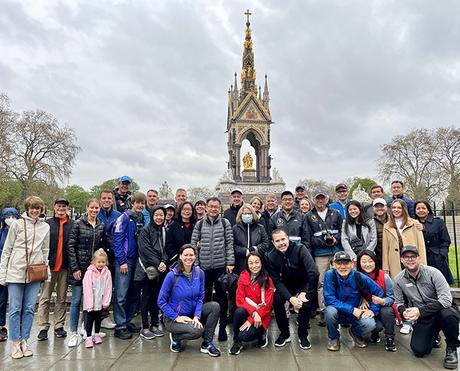
Don’t get me wrong—every time I lace up my running shoes, I am incredibly appreciative for my health and privilege and for the opportunity to do what I love. And that appreciation extends without exception to every race I run, London included. But appreciation is not the same as anticipation, and I simply could not wrap my mind around London, for two big reasons.
First, every World Marathon Major is a ginormous production of epic proportions that requires hours of careful planning and choreography just to reach the start line. Chicago and Tokyo were the easiest to navigate, as I was able to walk from our hotel (or in the case of Chicago, my friend Pete’s house) to the start line. New York was the most elaborate, requiring as it did two segments by land (subway, bus) and one by sea (ferry), followed by a lengthy wait at the start line on Staten Island.
So even before the starter’s pistol fires, each of the World Marathon Majors is to varying extents its own test of endurance. And for a life-long introvert like myself, the process can be equal parts invigorating and exhausting. As I’d learned the hard way in the lead-up to Marathon Monday in Boston, much of the energy I typically conserve for the marathon gets sucked away in the hectic days leading up to the race itself. So then by the time London 2023 rolled around, I’d had my fill of oversized marathon productions in general and the World Marathon Majors in particular.
The second reason I was less than thrilled to be running London, aside from the opportunity cost (I could instead have been running Providence, RI as my 36th state), was that I simply didn’t want to be there. This may not endear me to my British friends, but London is one of the world’s most overrated cities. With notable exceptions, it’s a gloomy (in April in particular), gritty, land-locked combination of old—check that, historic—grandiose architecture and incongruous contemporary design dominated by an anachronistic culture of royal entitlement and outdated traditions. Most of what we’d learn on our pre-race tour of the city would center on the monarchy, a topic I actively endeavor to know nothing about. I couldn’t tell you who came from who’s womb, who married whom, or who’s in line for what title by birthright. I’ve not seen a single episode of “The Crown,” or “Bridgerton,” or “Downton Abbey,” or even “Game of Thrones.” I don’t care for castles. I’m not a fan of palaces. I don’t like tea, or “pigeon sweat” as fellow American Ted Lasso sagely refers to it. I’m not big on bland cuisine. And most of what I know about Harry and Meghan I learned from watching a less-than-flattering South Park episode.
(Fortunately, recent numbers suggest the pomp and circumstance of the monarchy is wearing thin on even the Brits themselves at this point.)
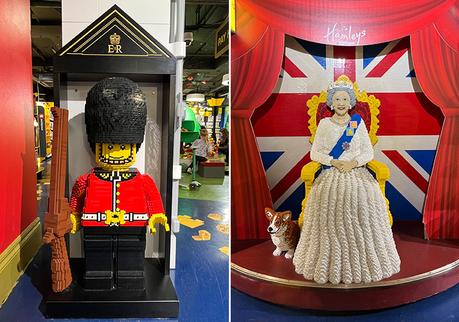
Even the River Thames—a murky waterway that, like a distended serpent, traces a slow and sinuous path through the heart of the city—is overhyped, though not through any fault of its own since the river is flanked on either side by concrete embankments and urban overkill.
All that said, I understand London is a perennial favorite of travelers worldwide (and Russian oligarchs favor it as well); likewise, its marathon is arguably the world’s most popular. And I respect all the love that London gets, I really do. But I prefer cities that offer some semblance of natural beauty—attractive green spaces, for example, or an active harbor, or maybe even a coastline. As Olde World (i.e. European) cities go, I loved Berlin—the city more than the race—with its world-famous Tiergarten as the dynamic centerpiece of the city. Different strokes for different folks, I reckon.
So then why not wait on London? Because given my extended injury and the nagging uncertainty of how my untested leg would respond to the distance, I wanted to ensure I got the most out of my remaining mileage. That meant completing the World Marathon Majors, stat. And that meant running London now. With 15 U.S. states and two continents still remaining, the sixth World Marathon Major was the lowest-hanging fruit available to me. And honestly, 10+ years after running my first Major in Chicago, it was time to seal the deal.
There would be a silver lining to my London experience—thanks to an off-handed comment on social media, sometime in March I’d discovered that my long-time friend, travel companion and frequent RaceRaves graphics consultant Matt would be in London to support his brother Paul’s own Six Star journey. Paul, a member of New York Road Runners, would be running to capture his 4th star in the series, with only Boston and Tokyo remaining. This heartening nugget of good news raised my spirits and amped up my interest in London considerably.
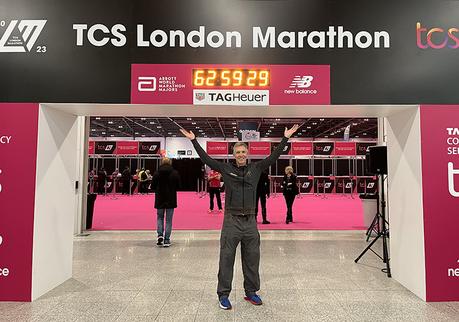
London Calling 🇬🇧
So it was that by the time we touched down at Heathrow Airport on Thursday, three days before the 43rd London Marathon, for better or worse I was crackling with pent-up marathon energy. Certainly I felt as prepared as possible, having ramped up my training as much as the residual scar tissue in my lower leg would allow and having run two solid half marathons in the past two months, including a comfortable 1:50:02 finish at the Oakland Half in March. But I worried that the sheer adrenaline of race weekend in London coupled with the anticipation of running on such a huge stage after such a long layoff would prove tough to temper.
Our Marathon Tours package included lodging at the swanky InterContinental London Park Lane in the upscale neighborhood of Mayfair and in close proximity to the city’s main attractions including Buckingham Palace, site of the marathon finish line. Dropping our bags at the hotel, we hopped the Tube (i.e. the London Underground or subway) and headed to the pre-race expo in an attempt to avoid the claustrophobic crush of crowds and slim pickings of race merchandise that are Friday and Saturday at the World Marathon Majors.
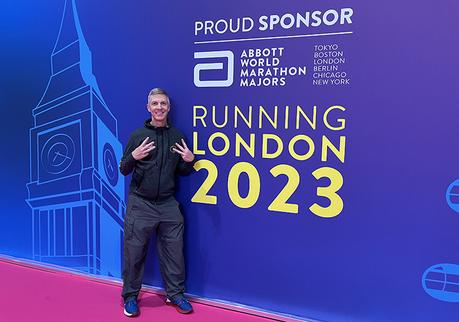
London is home to an estimated 9.65 million people, more than any U.S. city, and at any given time it feels like most of them are packed into the Tube. Every train seemed to be operating near capacity during our stay, and I’d quickly tire of leaving daylight behind and descending by escalator or stairs deep into the subterranean bowels of the city, only to board another subway car filled with silent faces cast downward to avoid eye contact. (In fairness, I’m typically a fan of public transit but dislike the New York subway for the same reason.)
Located an hour from our hotel and across the city in the ExCeL Centre, the expo (aka the London Marathon Running Show) was as massive as expected. At the same time, the floor plan—which included registration tables, vendor booths and speaker stages—was masterfully laid out to optimize the flow of foot traffic. The only (strategic) bottleneck would come immediately after packet pickup and before the main body of the expo, as all runners were channeled through the New Balance sponsor booth where official race merch could be purchased, much like the familiar gift shop located at the exit to each Disneyland attraction. The ploy admittedly worked on me, as I came away with London Marathon-branded shoes, running tee and light jacket for running in the rain—the latter a must-have for someone who lives in drought-prone Los Angeles. Typically I don’t buy merch for the World Marathon Majors because seemingly every runner owns a Boston Marathon jacket or New York City Marathon tee that they wear every chance they get. And yet, given my appreciation for simply being in position to run again after 16 months of uncertainty, I couldn’t help myself.
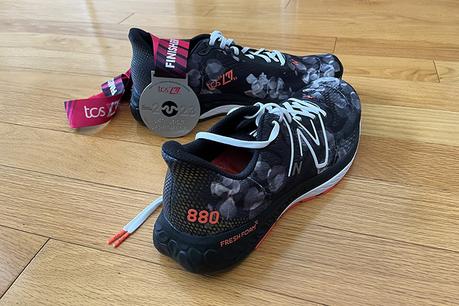
On Friday morning, we boarded a charter bus for a guided tour of the city with our Marathon Tours group. Though not usually an aficionado of these types of tours, I’d found the analogous tours in Berlin and Tokyo to be informative and educational outings that provided a compelling overview of each city, much more so than we would have gotten on our own.
The tour featured its share of centuries-old landmarks, red-brick facades and commissioned statues under gray skies and a steady drizzle. Our guide offered frequent references to royalty past, present and especially future, as the Coronation of King Charles III would take place two weeks after the marathon. As such, the grounds of Buckingham Palace—as well as many of its usual photo opportunities—were marred by the rows of temporary seating and fencing already in place for the Coronation. Though we missed the Changing of the Guard ceremony on our tour, Katie and I would see a curious sight the next day as a member of the King’s Guard strolled leisurely away from the palace through Green Park in full uniform.
It was on casual walks like this, overhearing random snippets of other conversations, that I discovered my favorite thing about London: with upwards of 300 languages and dialects spoken, London is one of the world’s most cosmopolitan cities. I was fascinated by the sheer number of people in this English-speaking city for whom English was not their native language, and coming from Los Angeles I felt strangely as ease.
After stops in and around Buckingham Palace, St. Paul’s Cathedral and Tower Bridge, the bus dropped us off at the race expo, which as expected was now significantly more crowded than the day before. There we took the opportunity to meet and chat with Wayne Larden, the race director for the Sydney Marathon. Sydney is currently vying to (and likely will) become the 7th member of the World Marathon Majors and the Southern Hemisphere’s first Major, and we (i.e. RaceRaves) would be working with Wayne and his team to raise Sydney’s profile among our largely American audience of runners.
Katie and I then took a more leisurely stroll of the expo than we had the previous day, stopping by vendor booths (including the Cape Town Marathon, another World Marathon Major hopeful) and listening to a couple of insightful talks on the speaker’s stage to help me prepare for Sunday.
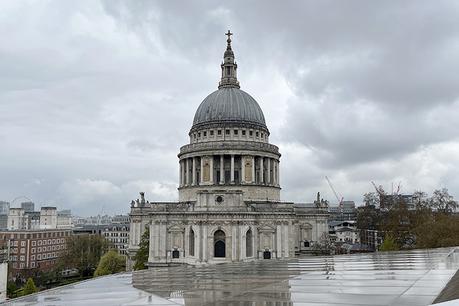
Saturday began with a dry cough and sniffle. Dismissing my symptoms, which I attributed to either the joy of pre-race tapering or the reality of being a stranger in a strange land, I headed out for a slow 30-minute shakeout run across the street from our hotel in Green Park. The area around Buckingham Palace was crowded and inaccessible due to in-progress races for the boys, girls and wheelchair / handcycle athletes that signaled the start of London Marathon weekend. After my run we met briefly with my friend Matt, whose brother Paul would be running London as his fourth star, to discuss the next day’s spectating strategy.
Given our shared apathy toward castles, Katie and I chose to skip the day’s group trip to Windsor Castle, home to British royalty for more than 900 years and the final resting place of Queen Elizabeth II. Instead we took a short Tube ride to Covent Garden, a high-end shopping and dining district in the city’s West End. Covent Garden boasts 200+ shops, restaurants and street entertainers—including the Jubilee Market Hall featuring a variety of crafts, antiques and collectibles—all laid out around a pedestrian-friendly piazza (public square). Having satisfied my need for retail therapy at the pre-race expo, we strolled idly along the busting brick and cobblestone streets, killing time and always with one eye on a sky that looked ready to rain on our parade at any moment.
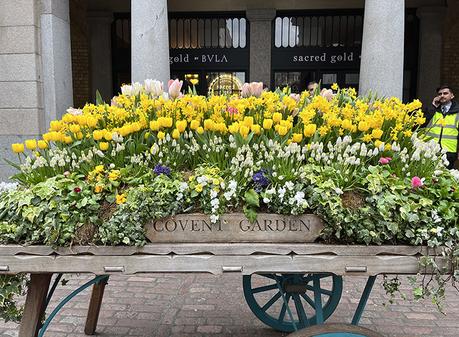
That evening we joined our Marathon Tours group for a pre-race pasta dinner in the hotel ballroom. Not surprisingly it was a large affair, with the Marathon Tours team hosting 450 runners along with 650 guests in London. Sydney Marathon Race Director Wayne Larden, whom we’d met at the expo a day earlier, was the evening’s guest speaker and shared Sydney’s ambitious plan to become the 7th World Marathon Major in the next few years. Right then and there, we resolved to join him in September to support his efforts and to see for ourselves what Sydney was all about while also notching my 6th continent.
Chatting with many fellow runners at the dinner, I was reminded of a truth I’d almost forgotten since my last World Marathon Major in Tokyo in 2019—the folks you meet at World Marathon Majors, the ones vying for Six Star glory, are a different breed than even the usual crazy marathon runner. The series clearly attracts Type-A personalities. Six Star hopefuls tend to be single-minded of purpose and hyper-focused on finishing the Majors as soon as possible. To many of the folks I met, their Six Star journey was all-consuming and their running plans had been—if not derailed, then at least hijacked—by their obsessive pursuit of the Six Star Medal. Until they crossed that 6th and final finish line, nothing else mattered.
Whereas I’d leisurely run the six Majors over the course of more than a decade—in fact, I’d run my first three in Chicago, Berlin and New York even before the introduction of the Six Star Medal—most of the runners I met in London and Tokyo had charted a much more abbreviated and intensive course. At the same time, many bemoaned the difficulty of qualifying for Boston, or the challenge of getting into Tokyo and London via the random lottery, or the overall cost of the Six Star journey. The longer each person’s timeline, it seemed, and the more their expenses and injuries mounted, the more it became about the destination rather than the journey.
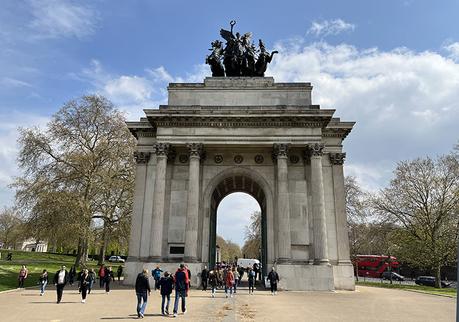
As much as I value the opportunity to visit each of the six cities and run each of the six races, for me the hype of the World Marathon Majors has always exceeded their appeal. They are in large part social media monstrosities, and the epiphany for the World Marathon Majors team came with the realization that nothing in the sport of running inspires greater FOMO than the Six Star Medal. I’ve been incredibly fortunate to run all six, but if I’m being honest, I’ve gained more joy from my quest to run in all 50 states and on all seven continents. And my two finishes at the Comrades Marathon in South Africa stand as arguably my proudest achievements.
For this reason, having saved (to my mind) the least for last, London felt like an anticlimactic ending to my World Marathon Majors journey. But an ending nonetheless.
After dinner we headed up to our room, where we truncated our sleep time by roughly 20 minutes after plugging too many electronics into our voltage converter and blowing a fuse, thus plunging our room (and apparently the room next door) into darkness. Fortunately the hotel was able to dispatch electricians quickly to our room, even on a Saturday night, and they resolved the issue in short order. Clearly you get what you pay for at the InterContinental London Park Lane, as that’s certainly not the response we would have expected from a Hampton Inn in the States.
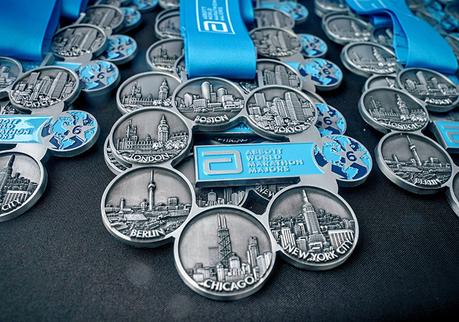
The Calm Before the Storm
With the arrival of Sunday morning, I awoke in darkness to an uneasy sense of relief. Race day, at last! I’d slept off and on for maybe four hours; fortunately, the test of the National Emergency Alert System that we’d been told to expect at “3:00” had not interrupted my already fitful sleep.
My dry cough and congestion had worsened slightly overnight, but there was nothing to be done about that now. My real concern was something I’d experienced only once before, on the morning of the Boston Marathon seven years earlier—profuse, uncontrollable sweating. Try as I might, I couldn’t stop perspiring. I don’t sweat much even in the heat, and we’d kept our hotel room on the cooler side, so this was seemingly a case of too much race-day adrenaline. The same situation hadn’t boded well in Boston, and I could only hope this didn’t portend a repeat of that near-disaster. Turns out I was right to worry.
I drank plenty of water, then polished off a quiet breakfast of peanut butter toast, coconut yogurt and granola in a dining hall heavy with groggy, nervous energy, before saying my farewells to Katie and loading onto the 7:30am shuttle bus for the meditative 30-min drive to Greenwich Park. Not being in a talkative mood, I was lucky to find myself seated next to a Polish fellow who scrolled on his phone for the duration of the journey.
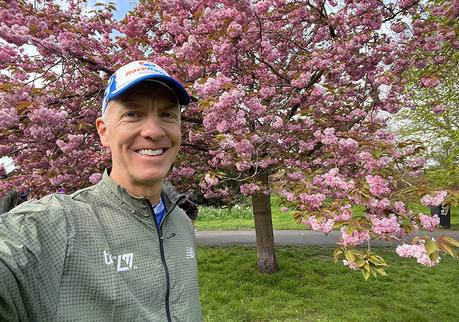
Testifying to the sheer magnitude of the London Marathon, the race deploys four designated starting areas. My starting area, the red area located in Greenwich Park, would be the largest of the four with 32,000 starters. Pulling up to the park at 8:00am, we deboarded and I wandered the large, grassy expanse until I found a strategic place to stretch out on the sidewalk close—but not too close—to the Portaloos. (This is one facet of race day where London stuck the landing, with row upon row of clean Portaloos stretching toward the back of the park to prevent painfully long wait times). There I sat conserving my energy, nibbling on an energy gel, and texting Katie until cell phone reception became untenable due to the sheer number of people on their phones in Greenwich Park.
As I sat watching the sky and awaiting my 10:15am-ish start time, I could hear but not see the PA announcer for the BBC who was practically begging folks in the park to join him “on the telly” for the live broadcast. Judging by the urgency in his voice, he didn’t have many takers. Clouds gradually obscured the once-promising blue sky and by 9:15am, as I watched runners of all shapes, sizes and shoe models idle about killing time, a light rain had begun to fall. Because this was London, and I wouldn’t have had it any other way.
After one last Portaloo visit, I headed straight to the kitbag lorry (i.e. bag drop) where I stuffed my pullover and gloves into my bag, handed the bag to a volunteer, and made my way through the crowd of randomly diffusing bodies toward the sign that welcomed Wave 2 runners for their designated 10:17–10:21am start time. While waiting, I chatted with a couple of runners who (prematurely) congratulated me after seeing the sign pinned to my back that announced London as my 6th and final Star. I’d been given the sign by the folks manning the World Marathon Majors booth at the expo.
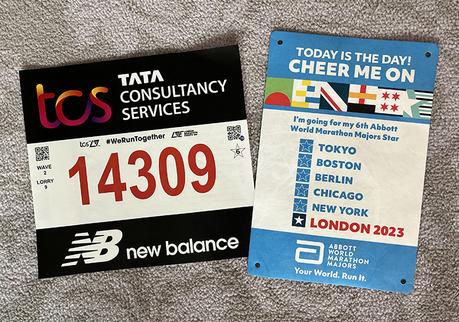
The trees provided some protection from the rain as we stood on the wet grass, waited, shuffled forward, waited, shuffled forward again, waited, and finally shuffled forward onto the road where the official start line came into view. This is it. Glancing around I couldn’t see a pace group for 3hrs50min (3:50), my best-case scenario finish time, which meant I was on my own. In retrospect, I wish I’d been more—let’s say generous—on my race registration and had predicted a speedier 3:30 finish time to get myself closer to the front of the pack and avoid the chaos that awaited.
I took a few deep breaths to clear my lungs as the starting airhorn sounded, and we watched on the big screen set up alongside the road as runners in Wave 2 crossed the start line. Moments later we were doing the same as one massive, metronomic organism surged across the start line in Greenwich Park and set its sights on Buckingham Palace.
More than ten years after my first World Marathon Major in Chicago, I’d reached the beginning of the end.
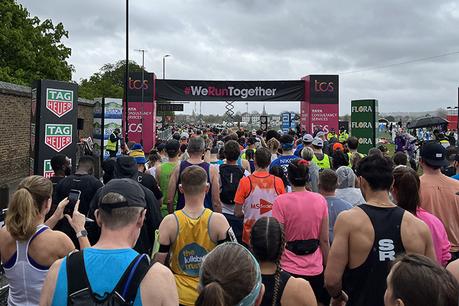
A Marathon Like No Other
A light but steady rain was falling as we exited Greenwich Park into the residential neighborhoods of Vanbrugh Park, passing tightly packed rows of multi-story brick flats with gabled roofs set close to the narrow street. Even here in the early miles and in the rain, spectators already lined the route. I made a point of high-fiving several kids in the opening couple of miles to help slow me down and ensure I kept my pace in check. Above all else today, I wanted to try to enjoy the moment.
Before the race, I’d struggled with the question of expectations and had ultimately conceded an “A” goal of a sub-4-hour finish, a reasonable time based on my training. This was due in large part to the fact that I’d run each of my previous five World Marathon Majors in less than four hours, with Boston being my slowest at 3:48:36. In reality, I had no idea what to expect from my recently injured leg, this being my longest run since Dallas in Dec 2021. My “B” goal I set at sub-4:15, while my “C” goal would be to finish and finish healthy, since being able to run 26.2 miles on a healthy leg was my biggest goal of all.
Smart, closely spaced flats transitioned to retail establishments transitioned to less attractive residences and more commercial neighborhoods. These early miles struck me as the typical urban/suburban juxtaposition with a pinch of Victorian sensibility. Fast-forward a month or so, and I could imagine this area would come alive in the full bloom of spring; now, however, under leaden skies, the overwhelming impression was a muted palette of grays and browns.
Glancing to my right in mile 3, I saw a sight that caused a momentary surge of angst as runners from the other start lines merged with us to form one steady stream of traffic. I’d already found the slick, narrow roads leading out of Greenwich Park to be a tight fit for so many runners, and our numbers would only increase with these new arrivals. Which meant increased vigilance to avoid stepping on and being stepped on by other runners. I knew from experience (in Houston for example, where I was the final marathon starter by design) the energy required to navigate throngs of runners, and so I knew I had to tread carefully and avoid riding the brakes to try to conserve my quads.
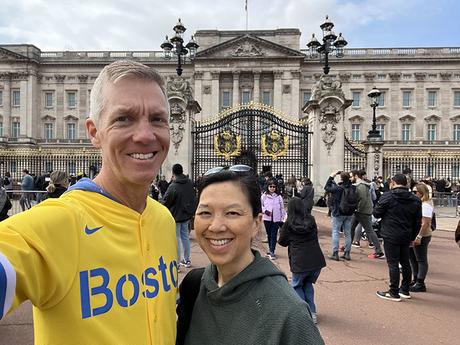
But that was easier said than done. More nondescript urban scenery passed, but the scenery was secondary to my immediate surroundings as I focused on my footing in the rain, on avoiding the feet of other runners constantly cutting in and out of my path, and on the boisterous crowds lining each side of the street. In fact, I’d seldom been less focused on the local scenery during a marathon. I frequently found myself having to weave around other runners and run through swinging elbows to keep my pace. It was a claustrophobic feeling and particularly for someone like myself who prefers smaller, less crowded races.
Seeing a familiar sign for a popular American sandwich shop, it crossed my mind: Shouldn’t Subway be renamed “Tube” here? This is the type of profound thinking that goes on during a marathon.
For a while, I did my best to follow the blue line on the road that signaled the shortest distance between the start line in Greenwich Park and the finish line at Buckingham Palace. After the merge with the other runners, though, it became too difficult to follow the line through the wall of bodies and limbs.
As we passed the University of Greenwich in mile 7, I experienced something I’m not sure I’ve seen in any of my nearly 50 road marathons, let alone in a World Marathon Major—without warning, we were forced to slow to a walk for several steps as the road narrowed dramatically owing to high water and the crush of spectators on both sides. I couldn’t believe it.
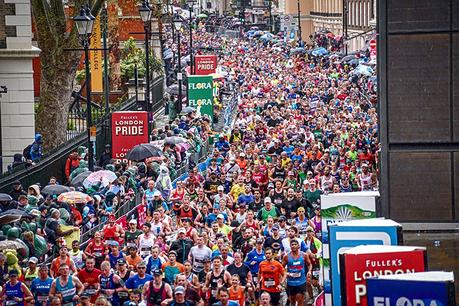
Just past the university we detoured from our straight-line path to circle Cutty Sark, a 19th century British clipper ship and the fastest of its time. Our arrival at Cutty Sark in all its glory made me realize that this course was not particularly scenic—rather, its nondescript commercial and residential neighborhoods faded into the background as the massive, screaming crowds demanded and got pretty much all of our attention.
After Cutty Sark I tried to refocus my efforts and calm my jittery nerves, telling myself there’d be nothing else to see until Tower Bridge at the midway point. Well, nothing except the natural beauty of Katie and Matt at mile 9 alongside Surrey Quays. I barely broke stride as I passed and pantomimed taking a picture to suggest we take a selfie at our next planned meeting point in mile 15.
At some point the rain stopped, and in mile 10 I knocked back my first energy gel. My stomach wasn’t especially happy with my decision, but then again that wasn’t unusual, and for now it was more important to try to stick to my nutritional plan.
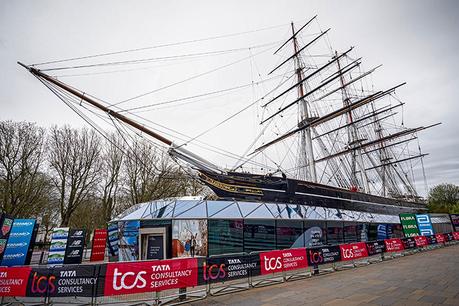
Running in this chaotic stampede was starting to take its toll, and I recorded my first 9-minute mile in mile 10. Still, I resolved to stay focused and maintain my current pace for as long as possible. Giving up a few seconds per mile wouldn’t be a problem and was, in fact, something I’d expected in the course of the race. I’d just hoped it wouldn’t happen this early.
Three times in London I remember running through a cloud of cigarette smoke, an unpleasant sensation that hearkened me back to Berlin, the only other European city in which I’ve run and, perhaps not coincidentally, the only other race where I’ve run through cigarette smoke. Later in the race the unmistakable stench of grilling meat wafted past my nose, reminding me of the many tailgate-style cheering parties encountered along the 90km route at the Comrades Marathon in South Africa.
In mile 12 I glanced up serendipitously to get my first look at the soaring spire of The Shard, the tallest building in Western Europe, before a hard right turn brought the arches of Tower Bridge into view directly above and ahead of us. As most London Marathoners will acknowledge, despite only spanning 0.15 miles the awesome architectural marvel of Tower Bridge is the hands-down highlight of the entire day—and for me, the entire city.

The spirited spectators lining the bridge were several deep and full throated, propelling us along by sheer force of sound. The decibel levels on Tower Bridge alone would have put Wembley Stadium to shame. And while I tried to enjoy the moment and smile for the photographers I knew would be there, my primary focus was on staying calm and breathing rhythmically, as I had begun to feel like a balloon that was slowly losing air. On the bright side, the wide-open stretch across Tower Bridge was a welcome reprieve from the claustrophobic feel of the first 13 miles.
I clawed back a bit of momentum coming off the bridge as we started the “out” portion of the out-and-back (because this course wasn’t narrow enough?) along The Highway into East London. Here we saw our much faster counterparts (already in their mile 22/23) as they passed us in the opposite direction, which I always enjoy and which prompted a surge of adrenaline.
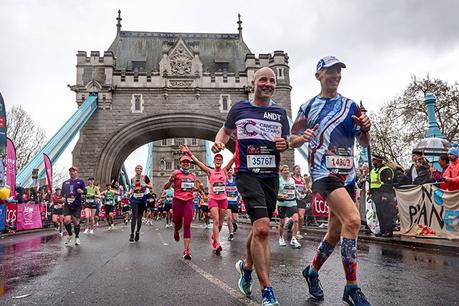
London was consistently the loudest marathon—and the loudest race—I’ve ever run. To be sure, each of the other five Majors boasts its own raucous crowds. London, however, was far and away the most overwhelming of the six, in large part because the spectators felt like they were on top of the course and inches from your head at all times, as I’d imagine being near the track at a NASCAR event must feel. It was like a 26.2-mile pep rally.
There were cowbells and kazoos and music and confetti cannons. And there were drums, LOTS of drums. Steel drums, taiko drums, drum ensembles, even a fellow banging away enthusiastically on his own enormous drum, no doubt much to the chagrin of the eardrums around him. Because what better way to maximize your noise-making potential?
Not only is London arguably the loudest marathon in the world, but it’s also become a proving ground for costumed runners, a significant number of whom come chasing world records. As such, London is now the marathon of choice for incognito runners. I saw runners dressed as Big Ben, as a Fuller’s London Pride Amber Ale, and as a conspicuously tall blue Na’vi from the movie Avatar. I saw a few rhinos (supporting a “Save the Rhino” charity) and a few dinosaurs (unclear if there was a “Save the Dinosaur” charity). I saw lobsters, owls, an unidentified rodent, automobiles, ballerinas, a legion of superheroes, a bone, a tooth, and a host of more intricate group costumes that involved two or more individuals running while connected together. For a while I ran near a two-legged Blackpool Tower that seemed to be running on fumes.
When the dust and accessories settled, 44 costumed runners set Guinness World Records at the 2023 London Marathon. These included fastest marathon dressed as a fairy tale character, fastest marathon dressed as a Christmas cracker, fastest marathon dressed as a body part (do you really want to ask?) and my personal favorite, fastest marathon dressed as a scientist. But the most well-supported runner at London 2023 had to be the woman who broke the world record for most underpants worn during a marathon. Her mom must be beaming with pride.
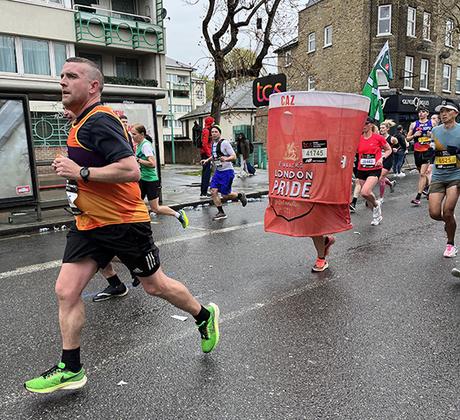
But if 44 costumed runners set world records, that meant all the other costumed runners on the course did not. And with all due respect to the record-setting lumberjack and the world’s fastest insect, the bloke who shows up at a marathon start line dressed as a lighthouse tends not to be the most, well, focused runner. As if London’s narrow roads weren’t enough of a challenge, many of the costumed runners on the course seemed to give little thought to the personal space of their fellow runners, specifically how their elaborate costumes may impinge on that space.
But wait, there’s more! London runners also get the opportunity to run alongside a sizeable number of first-time marathoners, since the race is incredibly popular with runners looking to check “marathon” off their bucket list. Which is brilliant, since I’m of the mind every able-bodied individual should run at least one marathon in their lifetime—after all, if you can run a marathon, who can say what else you may be able to achieve? And you can’t become a second-time (or 50-time) marathoner without running your first.
With great endurance, however, comes great responsibility. And for first-time marathoners, that means understanding the rules of the road. Unfortunately, the runner etiquette in London—which I’m assuming was due in large part to careless first timers—was as bad as any I’ve seen at a big-city marathon, much less a World Marathon Major. Sure, I recall in New York having to swerve around a runner or two who’d come to a sudden stop right in front of me. But the hijinks in New York were nothing compared to London, which felt a lot like amateur hour at the races.
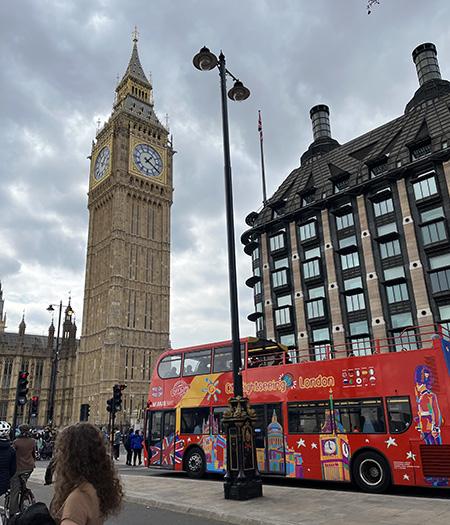
A Tragedy of Errors
One of the unwritten rules of crowded marathons is that you stay in your own lane. Yes, you’ll need to pass other runners and pull over for aid stations and the like, but for everyone’s safety erratic or unpredictable navigation should be avoided. In London, though, runners bobbed and weaved back and forth across the course like punch-drunk boxers, often not bothering to look while misjudging the speed & trajectory of surrounding runners. People accelerated and decelerated suddenly and without warning, like a child’s remote-control car.
In addition, and unlike every other World Marathon Major, London hands out full plastic water bottles at aid stations rather than drinking cups, a practice that only contributed to the problem (and to the world’s supply of plastic waste). Instead of tossing them off to the side of the course, runners would occasionally discard half-filled bottles by simply dropping them in full stride, the logical result of which was that same bottle ending up under the feet of the runner directly behind them with little warning. Similarly, I saw someone spit a mouthful of water toward the ground, only to have its trajectory interrupted by another runner’s leg. OOPS.
This was like the Keystone Kops in running shoes, a comedy of errors minus the humor. In contrast to my usual marathon, my eyes spent more time scanning the ground ahead for potential hazards than they did taking in their surroundings. In this sense, London felt more like a trail race than a road race. A new experience to be sure, and not what I’d expect from a World Marathon Major.
And despite all I’ve said so far, I certainly didn’t expect what happened next. As we approached Canary Wharf in mile 14 and shortly after I downed my second energy gel, a larger runner to my right waved at friends or family on the left side of the road before making the split-second decision to pull over and see them. Unfortunately, the shortest distance between those two points—him and them—was a straight line passing directly through me. Not the path of least resistance to be sure, but still the path he chose.

Clearly he never saw the collision coming as he hip-checked me sideways, his momentum knocking me off my stride. I probably would have hit the ground hard had I not pinballed off another runner—I felt awful for them, but what could I do? Inertia and gravity don’t give a shit. I never heard an apology as I quickly righted the ship and, after offering a few expletives under my breath, continued on my way.
Thanks to that hockey-style hip check, my right foot now ached near the shin bone owing to a reawakened injury that had bothered me off and on during training but which had remained dormant to this point. And my heart was jackhammering thanks to a fresh surge of wasted adrenaline that coursed through my bloodstream and which, in turn, was followed by a wave of fatigue and nausea as my body struggled to recover from being treated like an unwitting bumper car.
On the bright side, my injured leg was none the worse for the collision.
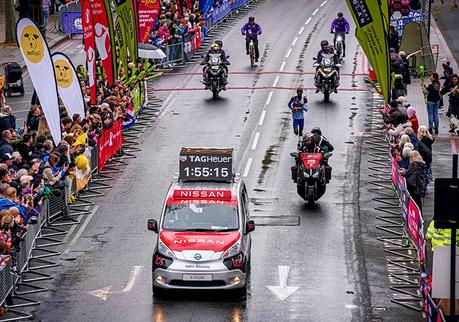
Looking for Katie and Matt in mile 15, I glanced up to see a sign announcing “Narrow St,” though whether this was simply a peculiar warning in a city where seemingly all the streets were narrow or rather a legit street name, I couldn’t be sure. As we circled Canary Wharf, near but not yet within view of the River Thames, I scanned the crowd for familiar faces while trying to gauge the discomfort in my ankle. Running among the soaring glass-and-steel skyscrapers of London’s central business district, it struck me again that during sunnier times, this was probably a very attractive area of a not-so-attractive city.
Apparently, as I’d discover after the race, Katie and Matt’s Tube station near mile 9 had been closed without warning between the time they’d arrived and the time they’d returned. So they’d had to rejigger their spectating plans on the fly, and I wouldn’t see them again until mile 19. Fortunately I knew the two of them were together, so I wasn’t concerned.
Prior to the collision, my pace had slipped above 9+ minute/mile, neither surprising nor alarming given this was my first marathon in 16 months. After the collision, though, the combination of a dodgy ankle and London’s overwhelming chaos began to take its toll. I couldn’t seem to find my groove, and in mile 17 I recorded my first 10-minute mile.
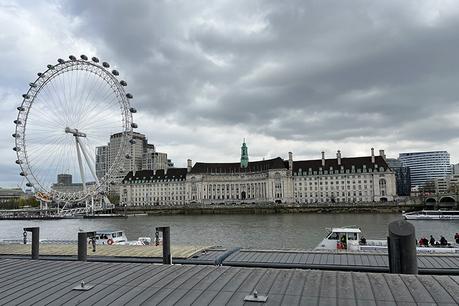
It would only get worse from there. Sometime in mile 18, I was forced to stop on a dime as, without warning, another runner sidestepped in front of me and slowed to a walk. Slamming on the brakes to narrowly avoid a rear-end collision, I felt a sharp stab of pain in the same ankle I’d aggravated four miles earlier. I let loose a profanity that was drowned out by the surrounding tumult, but the damage was done. And now every step hurt. Gritting my teeth I pressed on, assuming this too would pass and the pain would subside as it always had.
Except it wouldn’t. Every stride was uncomfortable, and though I wasn’t concerned with doing further damage to my foot, I knew I couldn’t run another 9+ miles like this—and especially with no guarantees that the same thing wouldn’t happen again. I was in no shape to navigate other reckless runners. I was reminded of the only other time I’d run a race while injured, 10 years earlier at the ET Full Moon Midnight Marathon in Nevada when I’d twisted my ankle at mile 17 and run 9+ additional miles in the dark with what felt like a sandbag strapped to my ankle. That mishap had been my own fault. Fortunately this was not a sprained ankle, so I didn’t expect the same grotesque swelling as a result. What a fucking optimist I’d suddenly become.
Forty years earlier, Joe Strummer of the English punk rock band The Clash had run London, finishing in 4h13m and famously joking that “The biggest temptation on the London Marathon is to run into a pub along the route.” At that moment, I couldn’t agree more.
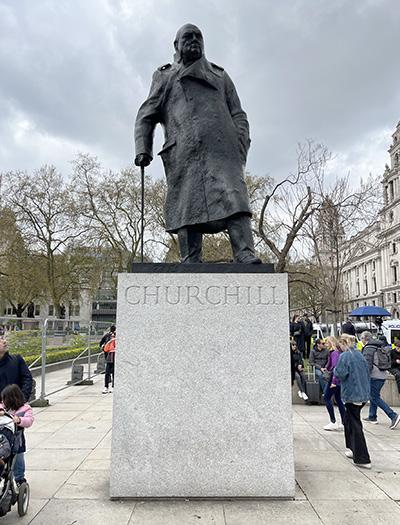
“If you’re going through Hell, keep going” –Winston Churchill
Both the foot and my exhausted, adrenaline-addled body earned a brief respite when I paused for a selfie with Matt and Katie in mile 19, a much-needed pick-me-up. I managed a weak smile to hide my distress (a learned skill I’ve honed over the years), then limped on as I felt my foot tightening rather than loosening with every step. I was determined to keep pushing, to reach the mile 20 marker before I stopped to walk and give the foot a break. More than anything, my focus now turned to one overarching goal—to finish the race without further injury.
Nonetheless, I forced myself to smile whenever I saw an official race photographer. That snapshot, that moment in time, may not tell the whole story—may not even tell the true story—but for most of us who don’t write painfully long race reports, years down the road as memories fade, it’s all we’ll have to remember the day. And the more races you run, the more adept you get at spotting photographers on race day.
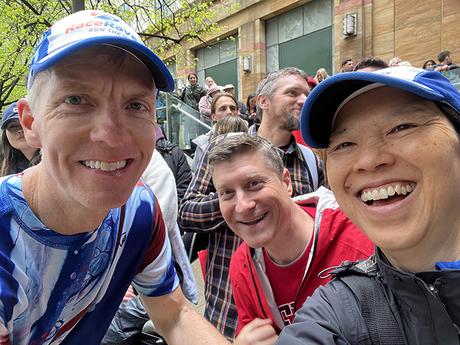
Reaching the mile 20 marker as we exited Canary Wharf, I finally threw in the towel and slowed to a walk, taking a few deep breaths and gratefully accepting a bottle from the water station. I did a few knee raises and shook out my foot as I walked, the din around me now even more pronounced. A confetti cannon erupted near my head, feeling like a sonic boom.
I was so tired of the London Marathon—more than a year of rehab and training to get back to marathon fitness, and this was the marathon I was running? At the same time, I wanted to try to turn these gators into Gatorade by enjoying the remaining miles as much as possible. Otherwise, this last 10K threatened to become an all-out suckfest.
As healthy runners passed me by, several wearing the same “TODAY IS THE DAY! CHEER ME ON” 6th Star sign I wore on my own back, I fought back frustration—being forced to walk during a marathon is miserable, and a mile takes forever at a walking pace. Walking is a leisurely activity, and I was categorically not in the mood for leisure. It didn’t help that I couldn’t escape the noise, which now felt like it was coming from inside my skull. As an introvert I have a huge aversion to random cacophony—the shrieks of an unhappy infant, the roar of an airplane flying directly overhead, or the volume for volume’s sake that was the case here in London. Loud music I embrace, but noise without rhyme or reason makes my brain hurt.
On the bright side, to me the best part of race weekend was the money raised for so many worthwhile charities. London claims to be largest annual fundraising event on the planet, a credible assertion given the number of unsuccessful lottery entrants who secure a spot instead through charitable fundraising. I must have seen dozens of runners sporting the logo of the Great Ormond Street Hospital (GOSH) Children’s Charity, which was named the London Marathon Charity of the Year and which ended up raising more than £1.8 million ($2.25 million) as a result.
The 3h45m pace group passed me… then 4h… then 4h05m, whom I knew had started in the wave behind me and so in my case was closer to 4h15m. And still I soldiered on.
Reaching the mile 22 marker I broke into a half-hearted run, the pain in my foot—and now the tightness in my quads from all the walking—precluding much more than a feeble jog. But at least this felt like progress, my exhaustion and aching foot notwithstanding.
We ended the out-and-back portion on The Highway and re-entered the City of London. Ahead of us, the distinctive edifices of the London skyline came into view including the gleaming, bullet-shaped Gherkin and The Shard, the tallest building in Western Europe and an architectural eyesore that towers above the city skyline. The splintered glass spikes that form the 1,000ft high spire of The Shard give the impression of a project left unfinished, a deliberate choice on the part of the designer.
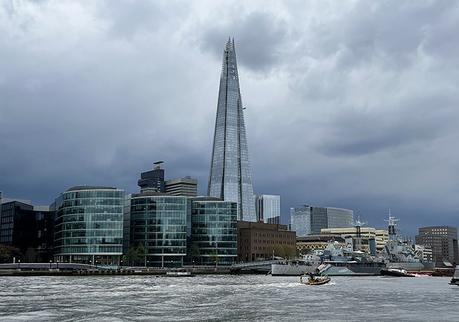
Picking up my pace briefly for the cameras, I walked a portion of mile 23 past the Tower of London and the Tower Hill Memorial, the site of ~125 public executions (including 93 beheadings) from 1388–1780 and 11 executions by firing squad in the early 20th century. Neither landmark registered in my mind given that I was in sensory overload and each was obscured by the raucous crowds standing several deep along this stretch.
Again I broke into a jog as the course became even more claustrophobic, with increasingly tall buildings lining either side of the narrow street. Even the occasional darkened tunnel or underpass offered no reprieve from the high-decibel mayhem, as two knuckleheads insisted on filling these quiet interludes by echoing each other’s screams. I was in a waking nightmare.
In mile 25 we followed the Victoria Embankment along the riverfront. On the opposite bank of the Thames, the Ferris Wheel-like profile of the London Eye and the curiously curvaceous glass tower of “The Boomerang” dominated the cityscape, for better or worse.
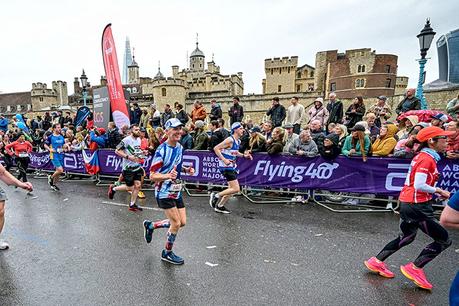
With roughly a mile to go, I ignored my barking foot and broke into a jog for the last time. I was determined to run the rest of the way, knowing the most boisterous crowds of the day were sure to be lining this final stretch. Approaching Big Ben, the Palace of Westminster (aka the House of Parliament) and Westminster Abbey, I felt a wave of appreciation wash over me as Neil Diamond’s “Sweet Caroline” filled the air, prompting runners and spectators alike to sing along in unison (“SO GOOD! SO GOOD! SO GOOD!”). Finally, I thought as I felt my body relax, motivation not aggravation.
Not realizing they’d be there, I didn’t see or hear Katie or Matt cheering as we turned directly in front of Big Ben and the Palace of Westminster. The two iconic facades commanded all attention, towering above us like the body and tail of London’s own Gothic Godzilla. Much like Tower Bridge, this magnificent stretch adjacent to Parliament Square was a course highlight that, together with Neil Diamond’s vocals resonating in my head, provided the decisive burst of energy needed to dig deep and focus on the finish.
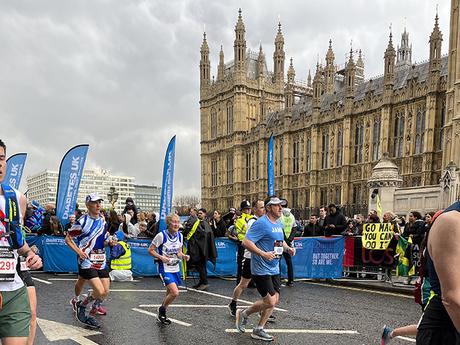
600m to go. The final countdown began as we cruised along tree-lined Birdcage Walk adjacent to St. James’s Park, where in October 2020 an elites-only edition of the 40th London Marathon had been staged during the pandemic. (It would be the only World Marathon Major held in 2020.)
400m to go. A right turn led us past Buckingham Palace and the rows of fenced-off Coronation seating. From there we wound our way around the Victoria Memorial, where the gilded bronze figure of Victoria, the Roman goddess of victory, watched over the exhausted runners from her perch atop the palace fountain. I couldn’t imagine a better sentry to herald our arrival.
200m to go. OMG, at last. Leaving Buckingham Palace behind, we turned onto The Mall for the final straightaway of my final World Marathon Major. Breathing a sigh of relief, I accelerated down a festive home stretch lined with gently fluttering Union Jack flags. Numb to everything but the finish line directly ahead of me, my pace dropped below 9:00/mile for the first time in hours as I tried to embrace the moment before crossing the line in an official time of… 4:25:22. YIKES.
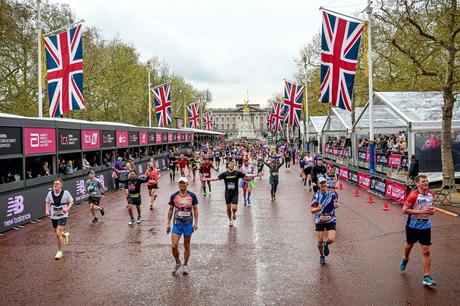
The Sweet Smell of Six-cess
In the weeks before the race, I’d tried to visualize this crowning moment and anticipate the emotions of that sixth and final finish line. Much like Ralphie Parker dreaming of his Red Ryder BB gun, I’d imagined an epic sense of finality washing over me, the clouds (it was London, of course there’d be clouds) parting and a fanfare of trumpets sounding from on high as a single tear rolled down my cheek and I thrust my fists skyward, before sharing a high five with a jubilant King Charles in the triumphant conclusion to my decade-long quest for Six Star glory.
Turns out I may have seen too many Disney movies in my life. Because finding myself in a sea of sweaty finishers, I wanted nothing more than to collect my medals, hit the shower and get out of there. I felt devoid of any emotion except relief, my adrenal glands long since depleted of their signature hormone. After wrapping myself in a heat sheet (aka space blanket), I was handed a heavy bag of drinks and nutrition including an Oatbake that looked distinctly unappetizing.
Gratefully I accepted my London finisher’s medal before being directed by friendly volunteers to the Abbott tent. There, a good-natured representative with arguably the best assignment of the day hung the long-awaited and hard-earned Six Star Medal around my neck, appropriately covering my London medal in the process. At that moment, as I posed proudly for pictures with my sleek new hardware, I had to admit—the Six Star was a beautiful freaking medal. And the fiasco of the past four hours notwithstanding, it had all been worth it.
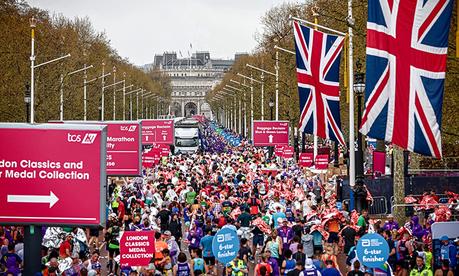
The two medals clinked together with every step, and I turned my London medal behind me to avoid sounding like a walking wind chime. After retrieving my drop bag, I shuffled through the densely packed throngs of runners and non-runners toward the family meet-and-greet area where Katie, Matt and his brother Paul presumably waited. Along the way I paused and sat for several minutes to rest my aching legs and arms (with two full bottles of liquid, my bag was heavy). And I struck up a brief conversation with a fellow from Thailand for whom this was marathon #50, with the goal of reaching 100.
As I resumed my stroll, everyone’s phones suddenly sounded in unison as the high-pitched siren of the National Emergency Alert System filled the air. So then the warning must have been meant for 3:00pm rather than 3:00am. Just another head-shaking misadventure in a day full of them.
Finding my group at last near the far end of The Mall, I threw my arms around Katie before meeting Paul for the first time. He’d run a great race, and I congratulated him on finishing in a personal best time of 3:29:39. I was happy to hear he’d had a positive experience in his fourth World Marathon Major, and I was reminded of my error in not estimating a faster finish time on my race application, since starting with the speedier runners presumably would have meant thinner crowds to contend with closer to the front and… who could say, really? A lesson for another day.
That evening, after eventually working our way back to the InterContinental London Park Lane via a convoluted route necessitated by all the Coronation infrastructure and road closures, Katie and I attended the Marathon Tours post-race reception in the hotel. During the reception, 14 new finishers were welcomed into the Six Star Hall of Fame—fewer than I’d expected in a group of 450 runners, and especially given that 376 new inductees earned their Six Star Medal in London this year.
Then we met Matt and Paul for an excellent dinner—a culinary and social highlight of our trip—at a Turkish restaurant named Sofra. And I was again reminded of why traveling to races—and particularly races that appeal to as diverse a swath of the population as the World Marathon Majors—is so often its own reward.
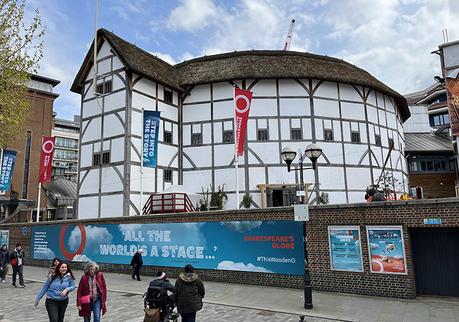
On Monday I awoke to another gray day and the realization that my cough and congestion lingered, worsened no doubt by the previous day’s exertions. Most tourist attractions in London require advanced reservations, which Katie and I hadn’t taken the time to research since we had no interest in time-honored traditions like the Changing of the Guard at Buckingham Palace. And so we happily avoided all museums, theater productions and official ceremonies in favor of more leisurely sightseeing strolls.
Faced with my low energy levels and still-cranky ankle, we decided to follow a recommended One Day in London itinerary and stroll the South Bank of the Thames. Taking our time we visited Buckingham Palace, Big Ben, the Palace of Westminster, Trafalgar Square, the London Eye, Shakespeare’s Globe Theatre, Tower Bridge, and the Tower of London, among other sites. The day was pleasant for the most part, and we lucked out with only a modicum of rain and intermittently sunny skies. Unfortunately in London, a spring day without rain is like an NFL game without a concussion, and that night as my symptoms persisted and the heavens opened, we opted to stay in and order room service.
Before saying “Cheerio” to the city on Tuesday we took a walk to Regent Street to visit Hamleys, the world’s oldest and largest toy store. We also discovered the unassuming plaque, located in a narrow alleyway behind one of London’s most revered wine merchants, that commemorates the former home of the Embassy of the Republic of Texas from 1842 to 1845.
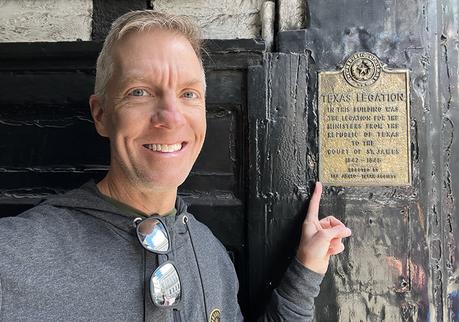
The greater part of the day was then spent on a mercifully smooth, 11-hour flight back to Los Angeles. Arriving home we unpacked, ate a light dinner and then headed to bed, where I’d remain for the next 18 hours as my body fought the good fight against whatever it was I’d had percolating in my system the past few days. Because whatever happened in London, definitely didn’t stay in London. (I never tested, but Katie would test positive for COVID-19 three days later—an outcome that felt as inevitable as Cookie Monster demanding dessert, given the tight confines of the London Tube at all times and particularly on race day, when the Underground was so overcrowded she felt as though she may suffocate if she wore a mask.)
Not only did our shared illness impact the end of our London adventure, but it prevented me from running Providence (R.I.) two weekends later, a marathon I’d been hoping to run as my first new U.S. state in 19 months. In fact, the effects of my illness would linger through May and end up impacting my performance at my next scheduled marathon in June. C’est la vie.
On a performance level London had been a stinker, to be sure. In the same race I’d experienced one of the highest peaks (Six Star finisher) and one of the lowest valleys (slowest road marathon) of my running career. What stung the most was that it wasn’t like I’d slacked off in my training—I’d prepared well for the distance and had put myself in position to finish in less than four hours.
Ultimately, though, none of that mattered, because next to finishing the race, the most important measure of success in London was that my previously injured leg had crossed the finish line feeling strong and ready to fight another day. After laboring through an uncertain 2022 that ended before it began, that in itself was a victory worth celebrating. And if you think getting into shape to run a marathon is tough, try getting back into shape once you’ve lost your hard-earned fitness. As a friend astutely pointed out, the mental challenge of getting back into shape is a whole different ballgame than getting there in the first place. So I’m proud to say—at least until my leg or some other fussy body part decides otherwise—that I’m back.
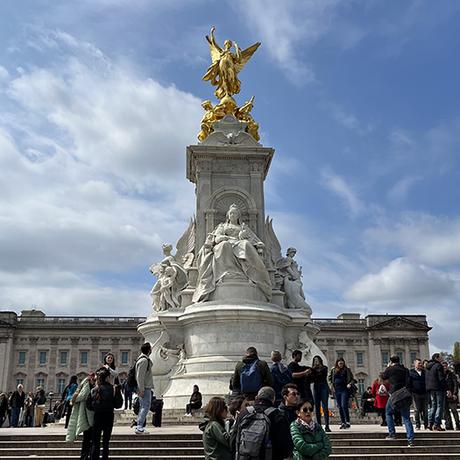
Despite my unenviable finish time in London, still I completed my Six Star journey with an average finish time of 3:42:43 across the six World Marathon Majors. My fastest time—and my first Boston qualifier—had been a 3:24:14 in Berlin, a race in which I’d inadvertently tied my shoes so tightly that I’d cut off all feeling to my toes. I have no interest in running any of the six again, though if the opportunity presented itself to run either Boston or Chicago, I’d have to give that strong consideration.
From an organizational perspective, the numbers in London didn’t add up. In 2014 when I ran Berlin, the city had hosted 29,000 finishers on its own narrow streets, which as I wrote at the time placed it “among the most crowded courses you’ll ever run.” But that was like a local 5K compared to London’s mind-boggling 49,000 finishers, making 2023 the biggest edition in the event’s 43-year history. I don’t claim to understand the mindset or motivation behind that decision, but to this participant the London Marathon felt a lot like the popular “clown car” circus routine, the goal being to pack as many runners as humanly possible onto the course despite the implications to the runner experience and potentially runner safety.
Unfortunately, as long as London remains one of the world’s six most popular marathons, catering to a captive audience by dint of its membership in the World Marathon Majors, it has no reason to change. With that in mind, I’d anticipate its continuing to chase New York City-type finisher numbers unless something happens to make the race organizers rethink their approach.
Until then, I wish each and every Six Star hopeful all the success in the world, because the medal and especially the journey really are worth the price of admission. And now, with my own Six Star medal in hand, I’m excited to focus on bigger and better running goals.
Because baby, I’m LonDONE.
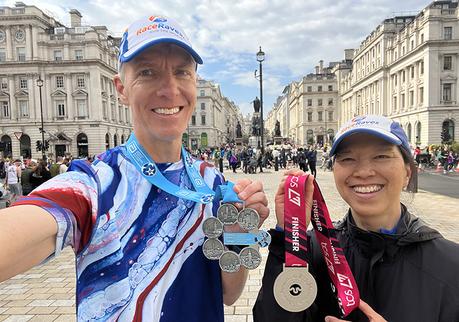
BOTTOM LINE: Though he died more than a century before his hometown marathon was born, long-time Londoner Charles Dickens’ words still ring true: It was the best of times, it was the worst of times. On the one hand, I did complete my sixth World Marathon Major and earn my Six Star Medal in London (best of times); on the other, my finish time was easily a personal worst for a road marathon (worst of times, literally) for reasons outside my control and which could have been avoided. To be clear, I have mad respect for any event that raises as much money for charity as London does and which bills itself as the largest annual fundraising event on the planet. Supporting charitable causes has become, in essence, its raison d’être. That said, and despite its global popularity and party atmosphere, London was hands-down my least favorite of the six World Marathon Majors.
If you’re reading this and are not a UK resident, odds are you have no choice but to run London—you’re more than likely somewhere along the path to completing the six Majors (including London) in order to earn what is arguably the sport’s most coveted award, the Six Star Medal. I don’t blame you in the least—it’s an epic journey with an enviable payoff. And if you’ve run any of the other five Majors (Berlin, Boston, Chicago, New York City and Tokyo), you know they’re all crowded races that pack thousands of fast-moving runners into limited space. And yet, I enjoyed them all. But when London posted on its Facebook page after the race that “The TCS London Marathon isn’t about running,” I couldn’t have agreed more. London hosts the world’s most popular 26.2-mile party, and as such it attracts a lot of first-timers and one-timers who are there to celebrate (not a bad thing) but who aren’t well-versed in the rules of the road (not a good thing). What set London apart from its fellow Majors was the appalling runner etiquette—dodging and weaving without looking, or throwing elbows and flapping arms wildly for the cameras or spectators, or stopping suddenly in their tracks without warning, or running in costume with little thought given as to how a bulky, oversized outfit might navigate such tight quarters. (London prides itself on the number of Guinness World Records set annually by costumed runners, so do expect to share the road with all manner of landmarks, superheroes, and extinct or endangered species.) To be sure, the lion’s share of the field was competent and mindful of their fellow runners. But every big-city marathon resembles a congested freeway in its choreographed flow of movement, and it doesn’t take long for careless (or reckless) behavior to cause avoidable accidents.
Case in point, in mile 14 I was side-swiped by a larger runner who didn’t bother to check his blind spot before cutting sharply across traffic to visit his cheering section on the sidelines. And in mile 18, I was forced to jam on the brakes after the runner ahead of me stopped suddenly to walk without warning. Together the two incidents caused an ankle injury that forced me to walk much of the remainder of the race. And walking during a marathon when you had no plans to do so sucks. Aside from a sprained ankle caused by my own carelessness in Nevada years ago, London was the first time I’ve ever injured myself during a race. The whole day felt more like a trail race than a road race in the amount of vigilance required, my eyes constantly scanning the ground ahead of me as I tried to avoid being stepped on or running into someone else. Spread that mental focus across 26.2 miles, and you’d better believe it takes a toll on physical performance.
(On a related note—if you do intend to run a sub-4-hour marathon in London, I’d recommend that on your race application you estimate your projected finish time on the speedy side, because presumably the closer you can get to the faster, more serious runners near the front, the thinner the crowds and the less chaos/fewer costumes you’ll have to contend with.)
For better or worse—and for many runners this is their favorite aspect of the race—London is also the LOUDEST marathon you’ll ever run. Admittedly I’m sensitive to volume, and so I tend to eschew loud, boisterous marathons in favor of smaller, quieter affairs. Even so, as raucous as the previous five World Marathon Majors had been, none of them consistently achieved the decibel level of London, where the cacophony of wildly cheering spectators started almost immediately and never let up. Not to mention that at several places on the course (including one stretch in mile 7 where the course bottlenecked, forcing us to slow to a walk for several seconds), the close-packed throngs felt like they were almost on top of us. I felt like I went to a rave and a marathon broke out. Rambunctious crowd support and bedlam for the sake of bedlam may look great in a 30-second sizzle reel, but the reality for an introvert like me can be unnerving and border on sensory overload. But again, I recognize that for many runners that’s the best part of race day. Different strokes, I reckon.
In the end, I feel like London’s ambition to throw the biggest running party on the planet prioritizes participant numbers over the runner experience. Hopefully this year was an outlier with its record number of finishers (48,791 per the results page), because in its 43rd year the organizers seem to have conflated “greatest marathon” with “biggest spectacle.” As a result, their race day has simply gotten TOO BIG. (For comparison, London totaled nearly 20,000 more finishers than when I ran an overcrowded Berlin Marathon in 2014 on similarly narrow streets.) For many runners and spectators, this amounted to a rollicking good time. And if you want to complete the World Marathon Majors and earn the Six Star Medal, you have no choice but to run London. But if you DO have a choice, and unless you have a specific reason to visit London (a city devoid of natural beauty and still fixated on the monarchy), I’d say do yourself a favor and skip it in favor of one of the many other excellent European marathons in a more interesting city. With so many other brilliant marathons in beautiful and rewarding destinations, London is simply not worth the hassle, the stress, and the hype—not unless you happen to be a UK resident, a raging extrovert (e.g. the runner cupping your hand to your ear and urging the already-deafening crowds to cheer even louder), or a serious Anglophile.
Independent from the marathon itself, I’d be remiss not to give a shout-out to the pros at Marathon Tours & Travel, who did a terrific job of organizing and executing for the 450 runners & 650 guests they hosted in London. MT&T has built and nurtured relationships with events like the London Marathon for 45 years, and it’s one of the reasons they’re the best in the industry. Sure you’ll pay a bit of a premium for their service—this is their business, after all—but if you’re an American who wants to run (and experience) London with minimal hassle, I can’t recommend them highly enough. Tell ’em Mike from RaceRaves sent you!

PRODUCTION: Admittedly it takes an enormous amount of time, resources and careful planning to pull off a race day as big and bombastic as London, and for that the organizers deserve huge credit. Not many races require four separate start lines to host nearly 50,000 runners, and as such it’s tough to fault the organizers for the 2½ hour wait I experienced from the time I stepped off the shuttle bus in Greenwich Park to the time I started running. (On the bright side, I’ve never seen so many Portaloos at a start line.) Despite being held across the city and an hour from our hotel, the pre-race expo too was masterfully laid out with enough packet pick-up kiosks to prevent long wait times plus a host of interesting speakers, vendors and events including the two candidate races vying to become the next World Marathon Majors, Cape Town and Sydney.
As expected, the temporary seating and fencing set up around Buckingham Palace for the Coronation inconvenienced runners and spectators alike. Fortunately, that was a one-time annoyance and not something future runners will have to contend with.
My biggest issue with London, as detailed above, is that the organizers cram their 50,000 runners onto some of the narrowest roads I’ve ever run, roads made narrower in places by the crush of spectators standing several deep on either side. Even as the notoriously crowded World Marathon Majors go, London was excessive in this respect. (See for yourself in the official race photo I’ve uploaded, taken at mile 7.) And my concerns were validated by the fact that I ended up injured due to runner recklessness and had to walk much of the second half of the race as a result—not how I’d hoped to experience my sixth Major. Try as it might, London is not New York City, and more is not necessarily better when it comes to the city’s narrow roads. After celebrating its largest marathon ever in 2023, it feels like now’s the time to pump the brakes and let some of the air out of London’s balloon before it blows up in someone’s face.
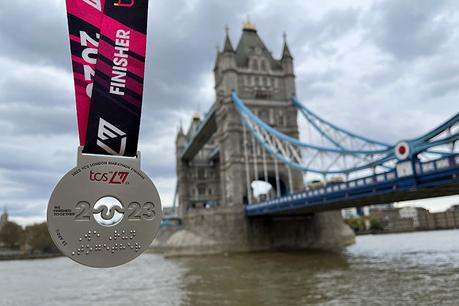
SWAG: As with most of the other World Marathon Majors, the swag was minimal but sufficient. This included a blue short-sleeve New Balance tee depicting London landmarks of interest in yellow silhouette, along with a finisher’s medal that displays the year prominently on front with those same urban landmarks subtly embossed on the back. The medal looks suspiciously like the 2022 version, which is perfectly fine if you’re Boston with its iconic blue-and-yellow unicorn, not so much if you’re London and seemingly relying on your status to excuse your lack of creativity. On the plus side, London may be the first medal I’ve earned with braille on the front, which apparently translates to this year’s race slogan, “WE FINISHED TOGETHER.”
One design note for future editions of the London Marathon: the race desperately needs a new logo. Since TCS became the title sponsor in 2022, the logo has been a stylized “LM” that feels apologetic and secondary to the TCS branding. The logo doesn’t stand out on any medium on which it’s used, and nobody who sees my London Marathon tee will recognize it for what it is. So it’s time for London to take a cue from Boston (unicorn), Berlin (Brandenburg Gate) and NYC (Statue of Liberty) and seize on one of its iconic landmarks—I’d suggest Big Ben or the Tower Bridge—as the centerpiece of a new logo for 2024 and beyond.
I also went home with my own Six Star Medal, which was all the swag I needed and the only reason I’d opted to run London in the first place. Mission accomplished!
RaceRaves rating:
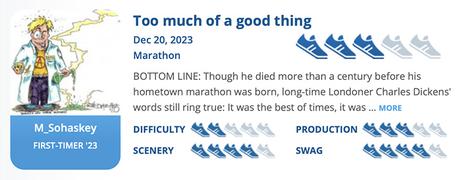
FINAL STATS:
Apr 23, 2023 (start time 10:21 am)
26.73 miles in London, United Kingdom (World Marathon Major 6 of 6)
Finish time & pace: 4:25:22 (first time running the London Marathon), 9:56/mile
Average AWMM finish time: 3:42:43
Finish place: 25,820 overall, 1,993/3,716 in M(50-54) age group
Number of finishers: 48,791 (28,487 men, 20,216 women)
Race weather: cool & rainy (50°F) at the start, cool & partly cloudy (50°F) at the finish
Elevation change (Garmin Connect): 1,506.6 ft gain, 1,613.8 ft loss
Elevation min, max: –4.6 ft, 463.9 ft
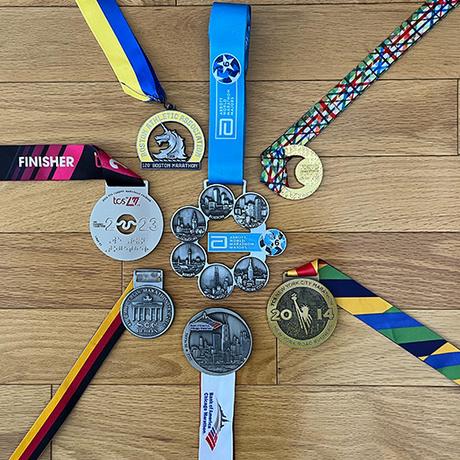
My Six Star medal collection (clockwise, from top left): Boston 2016, Tokyo 2019, New York City 2014, Chicago 2012, Berlin 2014, London 2023 and (center) the Six Star Medal
